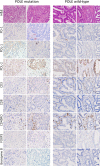The somatic POLE P286R mutation defines a unique subclass of colorectal cancer featuring hypermutation, representing a potential genomic biomarker for immunotherapy
- PMID: 27612425
- PMCID: PMC5356579
- DOI: 10.18632/oncotarget.11862
The somatic POLE P286R mutation defines a unique subclass of colorectal cancer featuring hypermutation, representing a potential genomic biomarker for immunotherapy
Abstract
Early-onset colorectal cancers (EOCRCs) may have biological or genomic features distinct from late-onset CRCs (LOCRCs). Previous studies have mostly focused on the germline predisposition conditions of EOCRCs, but we hypothesized that EOCRCs may have distinct somatic aberrations that accelerate cancer development. To identify the somatic aberrations that accelerate cancer development at an early age, we conducted whole exome sequencing for 28 polyposis-unrelated, microsatellite stable (MSS) EOCRCs with no known germline predisposition conditions. Surprisingly, we found two distinct groups in the context of mutational burden: 6 hypermutated cases with 2325 to 10973 mutations and 22 nonhypermutated cases with 47 to 154 mutations. Further analysis revealed that four of the six hypermutated cases had the same POLE P286R mutation. We validated this finding in 83 MSS EOCRCs and 27 MSS LOCRCs, which revealed that 7.2% of EOCRCs (6/83) had the POLE P286R mutation, which was not found in LOCRCs. Clinicopathologically, EOCRCs with POLE mutations occurred far more frequently in the right colon than in the left colon, affecting men more frequently than women. In summary, we have identified a unique subclass of colon cancer characterized by a hypermutation associated with the POLE mutation. The acquisition of the POLE mutation leading to hypermutation can accelerate cancer development. Clinically, this subset with hypermutation may be susceptible to immune checkpoint blockade.
Keywords: PD-1 blockade; POLE; early-onset colorectal cancer; hypermutation; immunotherapy.
Conflict of interest statement
The authors have no conflicts of interest to report.
Figures




References
-
- Ferlay J, Soerjomataram I, Dikshit R, Eser S, Mathers C, Rebelo M, Parkin DM, Forman D, Bray F. Cancer incidence and mortality worldwide: Sources, methods and major patterns in GLOBOCAN. 2012. Int J Cancer. 2015;136:E359–E386. - PubMed
-
- Ivanovich JL, Read TE, Ciske DJ, Kodner IJ, Whelan AJ. A practical approach to familial and hereditary colorectal cancer. Am J Med. 1999;107:68–77. - PubMed
-
- Young JP, Win AK, Rosty C, Flight I, Roder D, Young GP, Frank O, Suthers GK, Hewett PJ, Ruszkiewicz A, Hauben E, Adelstein B-A, Parry S, et al. Rising incidence of early-onset colorectal cancer in Australia over two decades: Report and review: Early-onset colorectal cancer. J Gastroenterol Hepatol. 2015;30:6–13. - PubMed
-
- Siegel RL, Jemal A, Ward EM. Increase in incidence of Colorectal cancer among young men and women in the United States. Cancer Epidemiol Biomarkers Prev. 2009;18:1695–1698. - PubMed
MeSH terms
Substances
LinkOut - more resources
Full Text Sources
Other Literature Sources
Medical
Molecular Biology Databases

